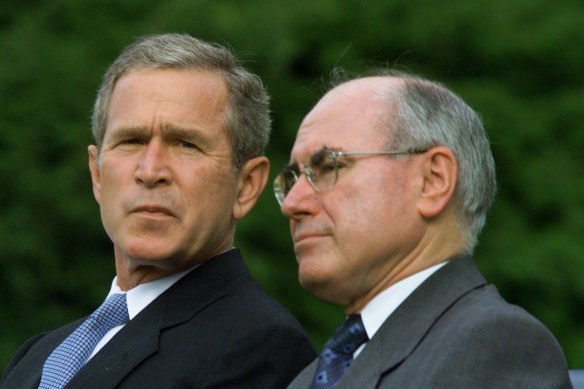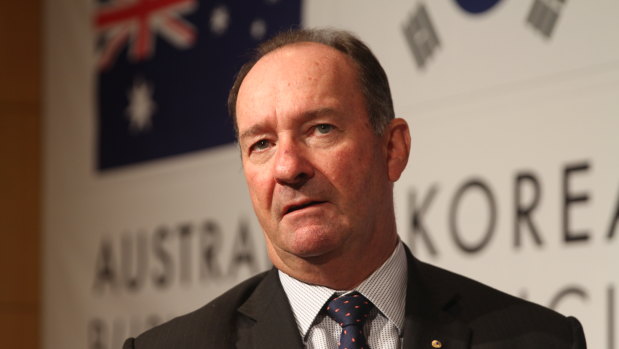This was published 1 year ago
Staying the course: Howard rolled Defence plan to cut Iraq presence
By Shane Wright and Matthew Knott
John Howard’s department rolled plans by the Defence Department in late 2003 to slash Australia’s troop numbers in Iraq and deploy some of them to help train a new Afghan army, previously secret cabinet documents reveal.
Warning that a cut in Australia’s forces in Iraq might attract criticism from the United States and undermine the nation’s most important military alliance, the Department of Prime Minister and Cabinet (PM&C) scotched Defence’s plan to reduce troop numbers in Iraq from 840 to 600 by January 2004.

John Howard (right) alongside US president George W. Bush, took Australia to war in Iraq in 2003.Credit: Getty Images
The documents also reveal diminishing interest in searching for Iraq’s purported weapons of mass destruction as the war progressed, while highlighting concern within the Howard cabinet that Australia had to be seen by the Bush administration to be “pulling its weight” in a war that would drag on for eight years and destabilise the Middle East.
Lifting a lid on disagreements between two of the nation’s most powerful government departments, the missing documents were released on Thursday by the National Archives, more than two months after other cabinet papers from the Howard government of 2003 were made public.
An inquiry headed by former spy chief Dennis Richardson in January found 78 documents – 14 of which related directly to the Iraq War – had gone missing within PM&C.
Clearing the department and the former Morrison government of deliberately misplacing the documents, Richardson found some had been locked away, hidden in sealed envelopes or were simply in boxes lost within PM&C.
Australia agreed to take part in the Iraq invasion in March 2003, joining the “coalition of the willing” made up of the US, Britain and Poland to find and destroy what were claimed to be weapons of mass destruction held by Saddam Hussein.
The documents released on Thursday reveal a key meeting in October 2003 at which then-defence minister Robert Hill proposed reducing Australia’s commitment of 840 personnel to about 600 early the following year.
Saying this would achieve a balance between helping Iraq and addressing growing pressures on the Defence Force, Hill argued for a reduction in air traffic control, Defence headquarters and logistics personnel.
He also urged cabinet’s national security committee to put more personnel into training the Iraq army and navy, deploy an “explosive ordnance disposal team” and send 18 troops to Afghanistan to help train its armed forces.
“Helping to better position the Afghan National Army to supplement and eventually replace the majority of coalition forces conducting operations against al-Qaeda and the Taliban would therefore be more consistent with the objectives of our original military engagement in Afghanistan, which reflected Australia’s more narrowly defined national interests in Afghanistan.”
Hill noted that proposing a reduction of Australian troops in Iraq was highly sensitive and risked upsetting the Bush administration.
“Australia should therefore handle with great care timely discussions with US officials on any proposed adjustments to the ADF presence in Iraq, emphasising our continued commitment to the US and the scale of our commitments in the Asia-Pacific region (i.e East Timor and the Solomon Islands),” Hill said.
But PM&C pushed back against any notion of reducing Australian troop numbers in Iraq while rejecting the idea of putting more people into Afghanistan.
“PM&C believes a substantial reduction in Australia’s commitment to Iraq announced before the end of 2003 might attract a critical US response detrimental to our broader alliance interests,” it said.
“PM&C believes this review should seek to achieve an outcome that would see continued credible ADF contributions both for Iraq and the War on Terrorism, in the near term at least.”
The documents reveal Howard had asked the Defence Department to abandon its proposal to send a specialist bomb squad to Iraq, but it had again put forward the idea in October.
PM&C also said other countries were doing work in Afghanistan, which meant Australia did not need to send troops.
“In the case of Afghanistan, and in addition to security considerations, US, UK and New Zealand forces are already providing training assistance,” it said.
The national security committee ultimately backed PM&C’s view over Defence.
Almost three years later, Australia would sharply increase its commitment to Afghanistan, sending troops to Uruzgan province. In 2008, it would use Australian troops to mentor and train elements of the Afghan army.
Australian troops would finally leave Iraq in early 2011.
‘Pulling our weight’
The cabinet papers reflect a consistent determination by the government to assure the US that Australia was “pulling its weight” in Iraq.
They show Hill, somewhat audaciously, proposing to sell a reduction in Australian troops as an “adjustment” rather than a “drawdown”. Avoiding upsetting the Bush administration and weakening the US-Australia alliance was a paramount concern.
In his October 2003 cabinet submission, Hill noted that he was recommending the troop reduction despite the “continuing poor security situation in Iraq hampering reconstruction efforts, and reports of the United States’ efforts to increase international participation in coalition operations in Iraq and the need for us to continue to ‘pull our weight’ on Iraq’s rehabilitation”.
Outlining the proposal, he said: “During the implementation of this strategy, US’s perceptions and expectations during any withdrawal or adjustment of ADF forces will require careful management”.
He continued: “The stakes are high for the US in Iraq, and there is an expectation that we will carry through in a responsible manner the commitments we have made.
“US has not been pressuring us to do more, understanding our other priorities, but as pressures increase, it is possible we will receive more requests.”
Stressing the importance of delicate communications with Washington on the topic, Hill said it was in Australia’s interests to maintain some influence over the US-led operation in Iraq.
“The current ADF presence has delivered good access and some, if not always as much as we would like, influence over the policies the US has adopted,” he said.
In a letter sent from Alexander Downer to Howard on August 14 ahead of a security committee meeting, the then-foreign minister argued that Australia’s 15-person team supporting the Coalition Provisional Authority “continues to ‘punch above its weight’ on critical tasks, which is much appreciated by US, UK and Iraqi counterparts”.
“We are not coming under significant pressure to do more,” Downer said, arguing that any additional deployments be focused on key Australian objectives such as agricultural rehabilitation and the return of Iraqis.
The missing weapons of mass destruction
In the Howard government’s decision to take part in the Iraq invasion, a key issue was the belief that Saddam held weapons of mass destruction.
The cabinet decision approving Australia’s participation cited Iraq’s weapons and the threat they posed to the world.
But the documents released on Thursday show that as the search for the weapons faltered, mentions of them declined to the point that on many occasions there was no official discussion of the issue.
By October 15, when Hill was arguing for a reduction in Australia’s personnel in Iraq, PM&C cited the weapons search as a reason to maintain troop numbers.
“This will be at a time when the allied coalition faces significant challenges in Iraq and the Australian government and coalition objectives which underpin Operation Catalyst (including the restoration of stability and security in Iraq and the search for weapons of mass destruction) have not yet been achieved,” it said.
Hill argued that “the ADF has provided a meaningful contribution to the US-led coalition to disarm Iraq of its weapons of mass destruction”, even though no weapons had been found in the seven months since the invasion.
The business opportunities
Even as American, British and Australian troops moved into Iraq, issues of business came to cabinet’s attention.
On March 21, the national security committee noted advice from Downer that the Bush administration “recognised the importance of Iraq as a traditional market for Australian wheat and that it did not intend to affect that relationship post-conflict”.
Any announcement about Australian food aid to Iraq, the committee said, should make clear that “Australia will take any steps necessary to preserve Australia’s traditional share of the Iraqi wheat market post-conflict”.
It noted a week later that an Australian donation of 100,000 tonnes of wheat to Iraq “should assist in maintaining Australia’s share of the Iraqi wheat market” as well as helping avoid food shortages.
A few days later, the documents reveal the government had sketched out a strategy for “advancing Australia’s commercial and economic interests”.

Former trade minister Mark Vaile was being encouraged to look at business opportunities for Australian companies soon after the start of the Iraq War.Credit: Eryk Bagshaw
Then-trade minister Mark Vaile was asked to “bring forward a detailed submission on the strategic opportunities and Australian capabilities and how best to pursue these wider Australian commercial interests in the post-conflict environment”.
Business interests were being briefed in early April about possible opportunities including contracts with America’s key aid agencies.
Australian oil exploration companies had expressed interest in commercial opportunities in Iraq, while the government was being urged to “ensure the best possible economic conditions for Australian companies”.
On April 4, the committee noted a proposal from Vaile for an Australian trade delegation to visit Iraq as soon as possible after hostilities ended.
Vaile would go to Iraq in 2006 to help salvage Australian wheat exports to Iraq, which were at risk of being rejected because of revelations the nation’s then wheat export monopoly, AWB, paid kickbacks under the United Nations’ oil-for-food program that ultimately found their way to Saddam’s regime.
Cut through the noise of federal politics with news, views and expert analysis. Subscribers can sign up to our weekly Inside Politics newsletter.